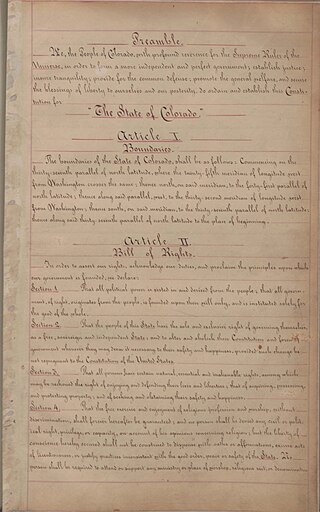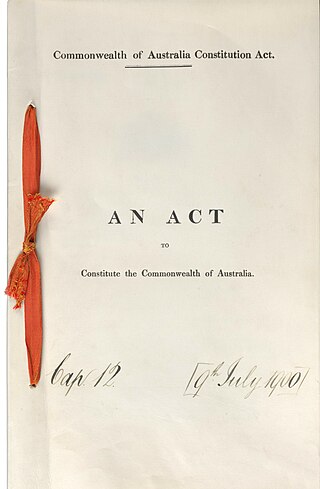
A popular initiative is a form of direct democracy by which a petition meeting certain hurdles can force a legal procedure on a proposition.
A constitutional amendment is a modification of the constitution of a polity, organization or other type of entity. Amendments are often interwoven into the relevant sections of an existing constitution, directly altering the text. Conversely, they can be appended to the constitution as supplemental additions, thus changing the frame of government without altering the existing text of the document.
A supermajority is a requirement for a proposal to gain a specified level of support which is greater than the threshold of one-half used for a simple majority. Supermajority rules in a democracy can help to prevent a majority from eroding fundamental rights of a minority, but can also hamper efforts to respond to problems and encourage corrupt compromises at times when action is taken. Changes to constitutions, especially those with entrenched clauses, commonly require supermajority support in a legislature. Parliamentary procedure requires that any action of a deliberative assembly that may alter the rights of a minority have a supermajority requirement, such as a two-thirds vote. In consensus democracy the supermajority rule is applied in most cases.
Amendments to the Constitution of Ireland are only possible by way of referendum. A proposal to amend the Constitution of Ireland must be initiated as a bill in Dáil Éireann, be passed by both Houses of the Oireachtas (parliament), then submitted to a referendum, and finally signed into law by the president of Ireland. Since the constitution entered into force on 29 December 1937, there have been 32 amendments to the constitution.
An entrenched clause or entrenchment clause of a constitution is a provision that makes certain amendments either more difficult or impossible to pass. Overriding an entrenched clause may require a supermajority, a referendum, or the consent of the minority party. The term eternity clause is used in a similar manner in the constitutions of Brazil, the Czech Republic, Germany, Greece, India, Iran, Italy, Morocco, Norway, and Turkey, but specifically applies to an entrenched clause that can never be overridden. However, if a constitution provides for a mechanism of its own abolition or replacement, like the German Basic Law does in Article 146, this by necessity provides a "back door" for getting rid of the "eternity clause", too.
In Australia, referendums are public votes held on important issues where the electorate may approve or reject a certain proposal. In contemporary usage, polls conducted on non-constitutional issues are known as plebiscites, with the term referendum being reserved solely for votes on constitutional changes, which is legally required to make a change to the Constitution of Australia.
The 1977 Referendums question was a successful amendment to the Australian constitution that allowed Australians living in territories to vote on future referendums. This question was put to voters alongside four others during 1977. With the success of the vote, the Constitution Alteration (Referendums) Bill 1977 passed. In future referendums, the votes of electors in the territories would be counted towards the national total, but would not be counted toward any state total.

The Constitution Alteration (Aviation) Bill 1936, was an unsuccessful proposal to alter the Australian Constitution to extend the Commonwealth legislative power in respect to air navigation and aircraft. It was put to voters for approval in a referendum held on 6 March 1937.
The Constitution Alteration (Marketing) Bill 1936, was an unsuccessful proposal to alter the Australian Constitution to ensure that the Commonwealth could continue legislative schemes for the marketing of agricultural produce such as the quota for dried fruits. It was put to voters for approval in a referendum held on 6 March 1937.
The Constitution Alteration Bill 1946, was an unsuccessful proposal to alter the Australian Constitution to give the Commonwealth power to make laws regulating employment in industry. It was put to voters for approval in a referendum held on 28 September 1946. The proposals was narrowly rejected, with a minority of 1.80% in the fourth state, South Australia.
The Constitution Alteration Bill 1974, was an unsuccessful proposal to alter the Australian Constitution to make it easier to amend the constitution and give voters in the Australian territories the right to vote in referendums. It was put to voters for approval in a referendum held on 18 May 1974.

The Constitution Alteration Bill 1977, was an unsuccessful proposal to alter the Australian Constitution to enable simultaneous elections for the House of Representatives and the Senate. It was put to voters for approval in a referendum held on 21 May 1977.

The Constitution of the State of Connecticut is the basic governing document of the U.S. state of Connecticut. It was approved by referendum on December 14, 1965, and proclaimed by the governor as adopted on December 30. It comprises 14 articles and has been amended 31 times.

A ballot proposition in the state of Arizona refers to any legislation brought before the voters of the state for approval.

The Constitution of the State of Colorado is the foundation of the laws and government of the U.S. state of Colorado. The Colorado State Constitution was drafted on March 14, 1876; approved by Colorado voters on July 1, 1876; and took effect upon the statehood of Colorado on August 1, 1876. As of 2020, the constitution has been amended at least 166 times. The Constitution of Colorado derives its authority from the sovereignty of the people. As such, the people of Colorado reserved specific powers in governing Colorado directly; in addition to providing for voting for Governor, state legislators, and judges, the people of Colorado have reserved initiative of laws and referendum of laws enacted by the legislature to themselves, provided for recall of office holders, and limit tax increases beyond set amounts without explicit voter approval, and must explicitly approve any change to the constitution, often with a 55% majority. The Colorado state constitution is one of the longest in the United States.

The Constitution of Australia is the fundamental law that governs the political structure of Australia. It is a written constitution, that establishes the country as a federation under a constitutional monarchy governed with a parliamentary system. Its eight chapters sets down the structure and powers of the three constituent parts of the federal level of government: the Parliament, the Executive Government and the Judicature.
Amending the Constitution of India is the process of making changes to the nation's fundamental law or supreme law. The procedure of amendment in the constitution is laid down in Part XX of the Constitution of India. This procedure ensures the sanctity of the Constitution of India and keeps a check on arbitrary power of the Parliament of India.

The principles of the current Constitution of South Australia, also known as the South Australian Constitution, which includes the rules and procedures for the government of the State of South Australia, are set out in the Constitution Act 1934. Its long title is "An Act to provide for the Constitution of the State; and for other purposes".
There have been 18 referendums in New South Wales, 8 of which concerned proposals to amend the New South Wales Constitution, half of which concerned the Legislative Council. While the Constitution of Australia was adopted after the 1898 and 1899 referendums in all of the proposed states, the Constitution of New South Wales, promulgated in 1902, was an Act of the Parliament of New South Wales which could be amended by Parliament. Since 1927 the Constitution has included provisions that can only be amended following approval in a referendum. 8 of the referendums, including 5 on the sale of alcohol, did not involve any proposed amendment to the Constitution. While these have traditionally been called referendums, they could also be described as plebiscites.
Section 123 of the Constitution of Australia details the method by which the federal parliament may alter the borders of the Australian states. It provides that any alterations must be approved by the relevant state parliament and ratified by a referendum in the relevant state.







